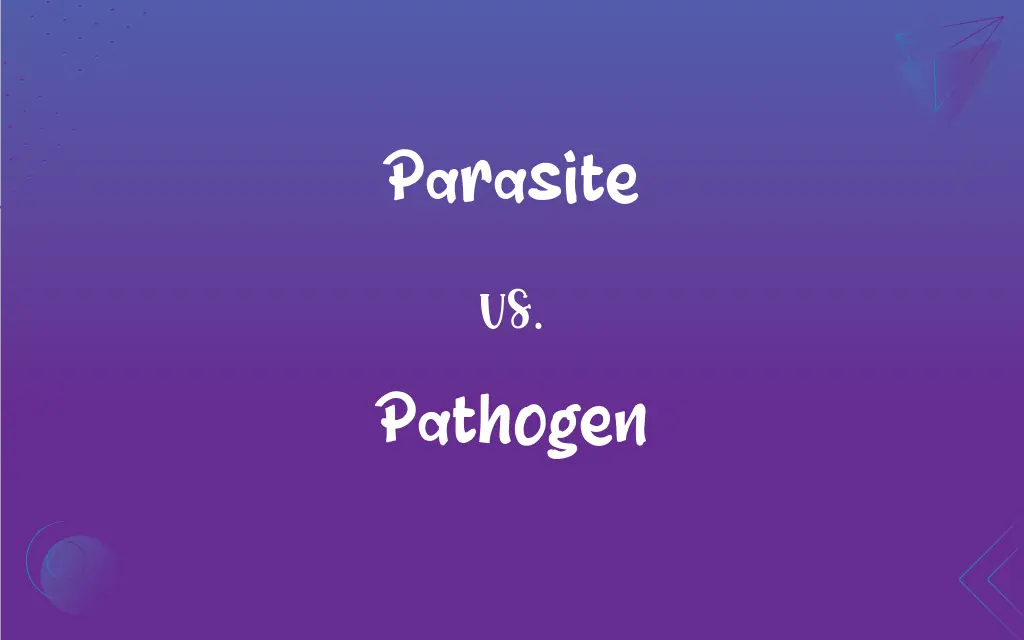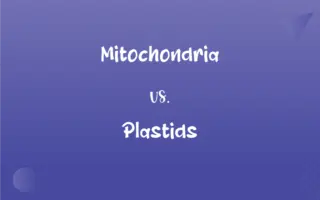Parasite vs. Pathogen: What's the Difference?
Edited by Aimie Carlson || By Harlon Moss || Updated on October 20, 2023
A parasite is an organism that lives on or in a host, deriving benefits at the host's expense; a pathogen is a microorganism that causes disease.

Key Differences
Parasite and pathogen are both terms that refer to organisms causing harm to another organism. A parasite is an organism that establishes a relationship with another organism, known as the host. In this relationship, the parasite derives nourishment or other benefits, often harming the host in the process. A pathogen, meanwhile, specifically pertains to microscopic organisms, such as bacteria, viruses, and fungi, that lead to diseases in their hosts.
The relationship between a parasite and its host can be complex and not always immediately detrimental. For instance, some parasites might live within a host for years without causing noticeable harm, while others may result in immediate damage or disease. In contrast, pathogens have a primary role: to invade host cells and tissues, reproduce, and subsequently lead to an illness or disease state in the host.
It's essential to recognize that while all pathogens can be considered parasites due to their harmful relationships with their hosts, not all parasites are pathogens. The term "parasite" encompasses a broader range of organisms, including large multicellular entities like worms. Pathogens are a subset of parasites that are microorganisms causing disease.
The interaction between parasites and their hosts has led to complex evolutionary relationships. Many parasites have evolved mechanisms to evade the host's immune system, ensuring their survival. Pathogens, with their disease-causing capability, often trigger immune responses, leading to symptoms ranging from mild to severe or even fatal.
In summary, while both parasites and pathogens interact harmfully with their hosts, they differ in their nature and impact. Parasites can range from microscopic organisms to larger entities, with varied effects on their hosts, while pathogens are microorganisms with a primary role in causing diseases.
ADVERTISEMENT
Comparison Chart
Definition
An organism that benefits at the host's expense.
A microorganism that causes disease.
Size & Complexity
Can be microscopic to macroscopic.
Typically microscopic.
Relationship
Lives on or in a host, may or may not cause disease.
Always associated with causing disease.
Examples
Tapeworms, lice, mistletoe.
Bacteria, viruses, fungi.
Outcome for Host
Varies, from benign to harmful.
Illness or disease state.
ADVERTISEMENT
Parasite and Pathogen Definitions
Parasite
An organism benefiting from another organism.
The tapeworm is a parasite living in the intestines.
Pathogen
Can survive outside hosts for varying durations.
Certain pathogens can survive on surfaces for hours or even days.
Parasite
Lives on or within a host species.
The lice are external parasites on birds.
Pathogen
A disease-causing microorganism.
The flu is caused by a pathogen known as the influenza virus.
Parasite
Can be harmful or benign to the host.
While some parasites cause disease, others are harmless.
Pathogen
Leads to immune responses in hosts.
When a pathogen invades, the body's immune system gets activated.
Parasite
Can be found across various species and environments.
Parasites are prevalent in both aquatic and terrestrial environments.
Pathogen
Often spreads from one host to another.
The pathogen responsible for the common cold spreads through airborne droplets.
Parasite
Has a symbiotic relationship with its host.
The parasite benefits while the host may suffer.
Pathogen
Can be bacterial, viral, or fungal.
Bacterial meningitis is caused by a bacterial pathogen.
Parasite
(Biology) An organism that lives and feeds on or in an organism of a different species and causes harm to its host.
Pathogen
An agent that causes disease, especially a virus, bacterium, or fungus.
Parasite
One who habitually takes advantage of the generosity of others without making any useful return.
Pathogen
Any organism or substance, especially a microorganism, capable of causing disease, such as bacteria, viruses, protozoa or fungi. Microorganisms are not considered to be pathogenic until they have reached a population size that is large enough to cause disease.
Pathogen
Any microorganism which causes disease; a pathogenic organism; an infectious microorganism; a bacterium, virus, or other agent which can cause disease by infection; - opposed to zymogene. The spelling pathogene is now archaic.
Pathogen
Any disease-producing agent (especially a virus or bacterium or other microorganism)
FAQs
Are all pathogens parasites?
Yes, all pathogens are parasites, but not all parasites are pathogens.
Can parasites be beneficial?
While most parasites harm their hosts, some can have mutualistic relationships where both benefit.
How do pathogens cause disease?
Pathogens invade host cells, reproduce, and disrupt normal cell functions, leading to disease.
Can a parasite live without a host?
Most parasites require a host for nourishment and reproduction.
Can parasites be used in medical treatments?
Yes, certain parasites are being studied or used for therapeutic purposes.
How does the body defend against pathogens?
The immune system identifies and combats pathogens through various mechanisms.
Can parasites evolve to be less harmful?
Yes, some parasites evolve to be less harmful to ensure their survival and reproduction within the host.
What's the primary difference between a parasite and a pathogen?
A parasite lives off a host, which may or may not cause disease, while a pathogen specifically causes disease.
What are common examples of pathogens?
Bacteria, viruses, and fungi are common pathogenic microorganisms.
Can one organism host multiple parasites?
Yes, an organism can host multiple parasites simultaneously.
How do pathogens spread between hosts?
Pathogens can spread through air, water, food, physical contact, or vectors like mosquitoes.
Are all parasites microscopic?
No, parasites can range from microscopic organisms to larger entities like worms.
Can plants have parasites?
Yes, plants can have parasites, like mistletoe.
Why are some pathogens drug-resistant?
Overuse or misuse of drugs can lead to the evolution of drug-resistant strains.
Do parasites always kill their hosts?
No, many parasites do not kill their hosts, as a living host can be beneficial for the parasite's survival and reproduction.
How do pathogens enter the body?
Pathogens can enter through inhalation, ingestion, cuts, or bites.
Are viruses considered pathogens?
Yes, viruses are a type of pathogen.
How can parasites be controlled?
Parasites can be controlled through medications, hygiene, and environmental interventions.
How can we protect ourselves from pathogens?
Good hygiene, vaccination, safe food/water practices, and avoiding contact with sick individuals can help protect against pathogens.
Are antibiotics effective against all pathogens?
Antibiotics are effective against bacterial pathogens but not viral ones.
About Author
Written by
Harlon MossHarlon is a seasoned quality moderator and accomplished content writer for Difference Wiki. An alumnus of the prestigious University of California, he earned his degree in Computer Science. Leveraging his academic background, Harlon brings a meticulous and informed perspective to his work, ensuring content accuracy and excellence.
Edited by
Aimie CarlsonAimie Carlson, holding a master's degree in English literature, is a fervent English language enthusiast. She lends her writing talents to Difference Wiki, a prominent website that specializes in comparisons, offering readers insightful analyses that both captivate and inform.































































